Say yes or no to Internet Explorer 7 (end)
Review the previous section
Security
For most of us, the most interesting aspects of the new browser are the new interface, tabbed browsing and RSS support. But with Microsoft, all is confidential. When you ask why IE7 is distributed via Automatic Updates, the product manager will certainly answer that the most important reason is to ensure security.
The latest security component was seen in IE7 as a phishing anti-toolbar. But Microsoft says there are more security components in the browser that users have never seen. They are even more important than antiphishing tools.
ActiveX is a major security hole of IE. Microsoft has also equipped some browser protection measures against ActiveX attacks. There are hundreds of purposes of using ActiveX and COM in Windows operating system at a certain website. Many purposes are known as using AcitveX in Windows Media Player to watch videos, but most of the rest are unknown. Some controls also allow malware to exploit scripting vulnerabilities to attack a PC.
In IE7, several hundred of these objects are left unused by default. That's better than the default allowed as in IE6. So if a user visits a website and tries to use one of the controls, he will receive a familiar security warning. After that, I have to say positively that he wants to run this control, then those controls will be activated. Security is increased because users have to choose the control to run. Only a few uninformed people are defaulted to some weak, easy-to-exploit objects. Microsoft believes that malware authors can hardly use ActiveX as a special exploit.
There are some exceptions in opt-in selection rules in IE7: a group of the most popular ActiveX options are set by default in Internet Zone in the permissions library. These controls allow applications like Windows Media Player to be widely used and considered harmless.
Because businesses often build in-house applications around ActiveX controls, these objects are set by default in IE7's Local Intranet Zone security settings.
In addition, Microsoft said that a large number of different vulnerabilities have been fixed, such as the VML vulnerability, which allows the Vector Markup Language to launch an attack.
With IE7, the default security level is set to medium (medium), while IE6 is medium-high (high average). But currently there are no lower security levels than medium. The medium-low and low (low) settings have been completely removed.
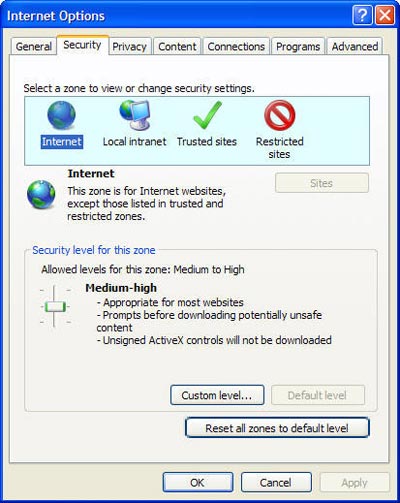
IE7 selects the average browser security feature as the default value
If you set some security settings in low mode, you will receive reminder information from Information Bar. And this warning will always appear until you change that security setting. There is no simple way to turn it off. Not only that, every time you reopen your browser, you get a big warning on the entire screen that your settings are not safe.
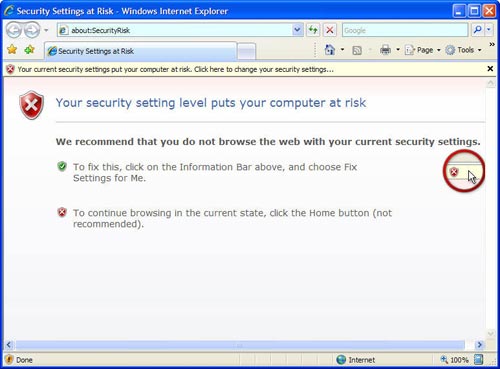
The screen warns users to set low security mode on IE7
In terms of some points, you will find this form of warning interesting. To restore the settings to your liking, you can click on the Information Bar section and select ' Fix Settings for Me ' on the menu that appears.

You must restore the default security value to stop the continuous warning screen
This, needless to say, everyone feels extremely uncomfortable. It seems that Microsoft protects users from users themselves. It even violates the rights of individual users. Windows Vista's User Account Control component is another example of this trend.
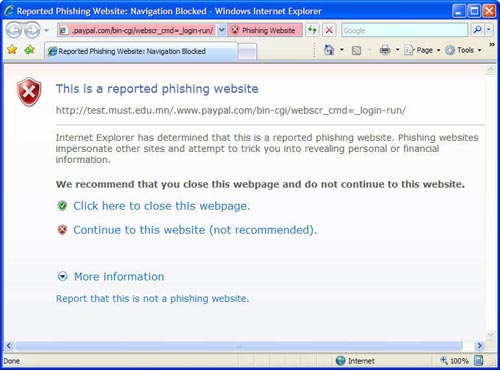
Anti-phishing function
Separate filters perform their duties very well. It blocks at least 80% of phishing websites, better than filters built in Firefox.
Better printing (printing) function
In front of newly added 'talents' such as tabbed browsing, security and RSS feed, the print control function seems quite neat. But that is one of the most useful changes in IE7.
There is an open secret that printing Web pages is one of the most annoying points on the Internet. How many times do you have to print a page, only to find the right side of the site that has been cut? IE7 fixes this problem by automatically spacing the web page so that it always fits when printed.
The printing function also has some other new components. Click the Print icon on the toolbar, select Print Preview , and you can view the text before printing and set options for the text after printing. You can choose to view multiple pages at the same time or view each page in a 12-page frame. You can also view each page with a width or a whole page and change between ' lanscape ' (horizontal) or ' portrait ' style (vertical). In addition, you can optionally print the title and post or completely remove them.
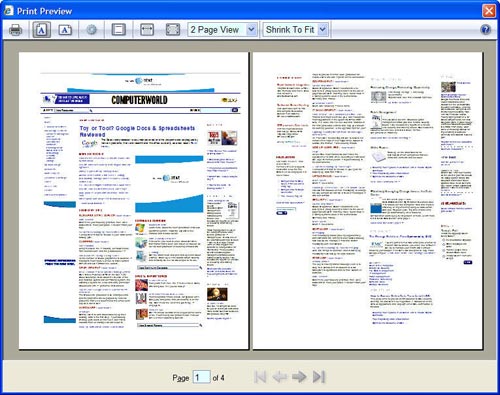
See 12 pages at once in the Print Preview screen
Good news for businesses
IE7 provides some interesting features for businesses as well as individual browser users. Group Policy can now be applied to all Internet Explorer components. Network administrators can better control and standardize browser usage and easily build browser configurations for large companies. In a Windows XP-Windows Vista environment, Group Policy can control all client settings at the same time, making it easier to manage.
Of course not all companies want to upgrade IE7 immediately. The new version may conflict with home applications that users access via Internet Explorer. Many businesses have calculated and prepared for the new IE7 upgrade with more complete security features. With these companies, Microsoft is providing more tools that can prevent automatic update of IE7 on aggregated desktops.
Bad news for professional users
Those who are professionals will not be satisfied with IE7. As mentioned above, if you change some security settings, you will receive a multitude of alerts until you change those settings again. You will even be annoyed to the point of crying or irritating with these warnings.
Moreover, the toolbar does not have many options. In IE6, there is a lot of controversy about adding or deleting toolbar buttons and functions, changing text sizes, placeholders, and so on. What you see is what you have to do.
Professional users hope they will have some platform to change IE so that it is more professional. But simply can't do it. In fact, there are a few significant options you can use to change or set options for the browser. But sometimes Microsoft gives users the feeling that the new browser seems to lock down on common user privileges like blocking malware.
Additional components add-on IE7 - not big numbers
Another area IE7 is taking seriously is the add-on components. These additional tools provide extensive functionality for the browser. Firefox with an unprecedented group of developers. And IE doesn't have anything now, from near to far, so far and near.
How to find IE add-on components?
You can go to Tools> Manage Add-Ons> Find More Add-Ons , or go directly to the Add-Ons section on Internet Explorer websites. Unfortunately most add-ons you find will not be free.
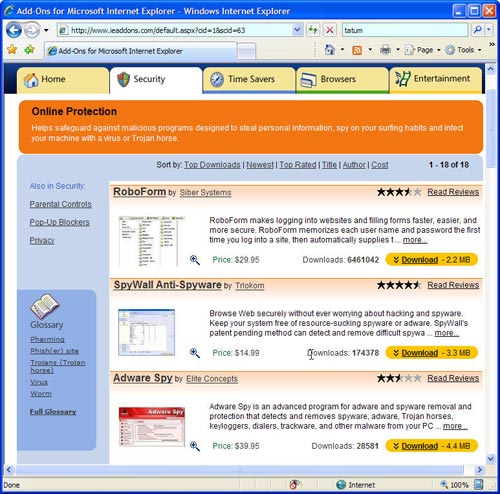
Many add-ons in IE require you to pay
Many of the add-on components to call are not designed to work directly inside IE and integrate with the browser to give you a better way to browse. In fact, to be fair, they don't really work with IE. Because they also work with any other computer browser, and can act as a standalone program. It doesn't look like an extension that integrates into Firefox to enhance browser functionality.
As a general rule, any add-on component designed to integrate into IE is not entirely for IE7. Up to this point, you will not find any single add-on tools that allow you to customize the way IE7 works.
There will be no new hope for IE7 add-ons, at least in the near future. For some reason, the biggest thing to do is to write an add-on. First you need a C programmer for Internet Explorer add-ons. As for Firefox, you just need to write a script. The number of people capable of writing scripts is much more than those who can write C code.
Microsoft is aware of the problem and says it will eventually create add-ons through script writing. But there is no certain time frame for this.
There are also cultural issues. A large number of people trust open source as an important step forward and . as a truth beyond Microsoft's closed loop. You won't find a similar community devoting time or effort to giving yourself to Microsoft as open source. So you won't have enthusiastic people willing to write IE add-ons like in Firefox.
Microsoft does not seem to do anything to promote the transition in add-ons. While the Firefox extension website running the Mozilla Foundation plays the full role in the open source movement. Microsoft's add-on website isn't even run by Microsoft. It is also owned by CNET's download library (Download.com).
Epilogue
IE7 has obvious and amazing improvements compared to IE6. With tabbed browsing, enhanced security, intelligent RSS support, better print control and a brighter interface, IE7 is rated to have many extensions that don't inherit from IE6.
But this browser is not perfect yet. If you use a tab, you need to be upgraded more. In addition, Microsoft needs to change the way that add-on tools are created to scale up add-on writers in a way that builds a growing and growing add-on system.
Microsoft must change its perspective towards professional users. The founder of the famous Ford automaker Henry Ford said that his customers could buy a Model T in any color, just black. ' Microsoft seems to have the same opinion in this new version of Internet Explorer.
Microsoft chiefs say the next version of Internet Explorer will focus on professional users. Although there are not yet any specific components to ensure, they say that the new version will provide more options on the entire toolbar-like system, adding background and many similar components. In fact, Microsoft wants to include IE7 components, but they don't have enough time to build.
But after all, if you're a professional user, try upgrading this browser at least once. You will get enhanced security with a significant amount of new functionality. Hopefully the next release of the new version will give you more things to adorn the browser at your own discretion.
You should read it
- How to secure your accounts with U2F security key?
- Steps to adjust security settings in Microsoft Edge
- Microsoft is about to die at Edge, replacing it with a new browser based on the Chromium core
- The best security utility for Internet Explorer
- Microsoft 'paralysis' Chrome is malware
- Dynamics of Google, Apple and Microsoft when the browser has a security error
 The risks are unavoidable when surfing the web
The risks are unavoidable when surfing the web DaVinci goes with MontaVista
DaVinci goes with MontaVista Mashup for business applications
Mashup for business applications Attention when buying a printer
Attention when buying a printer 15 interesting questions about Firewall
15 interesting questions about Firewall First look at Microsoft Zune
First look at Microsoft Zune